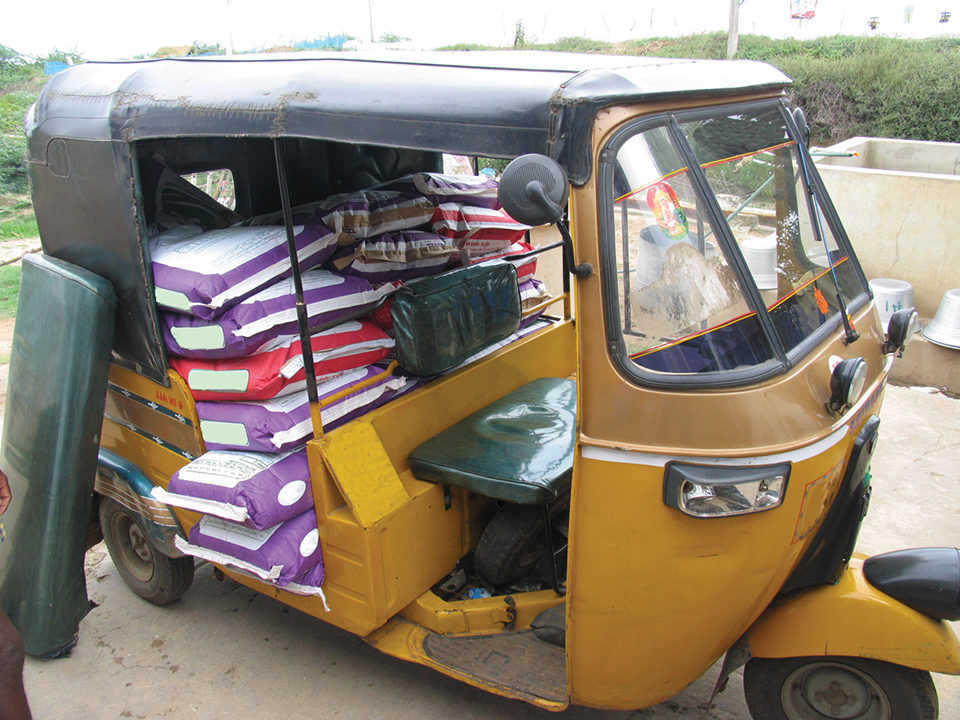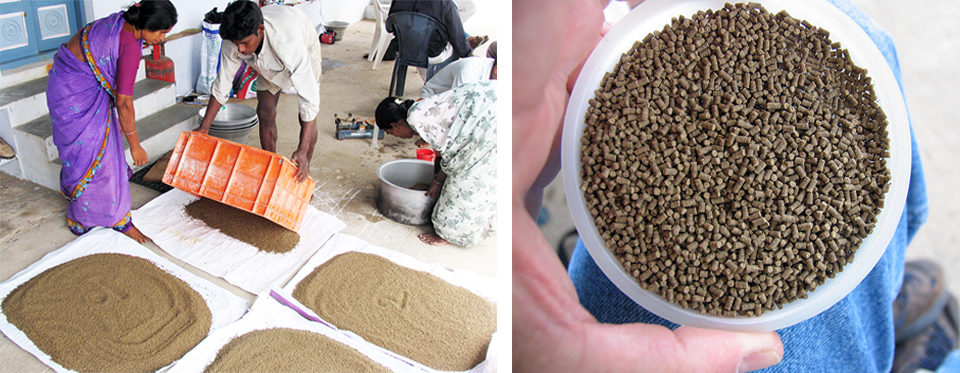Growing sector can support aquaculture diversity, development

Aquaculture production of shrimp and fish in India was expected to reach 3.4 million metric tons (MT) in 2010. This combined production depended on approximately 852,000 MT of aquaculture feeds – a comparatively low feed usage. A great portion of the Indian fish-farming industry makes limited use of modern feeds, providing vast potential for the Indian feed sector to grow in the future based on aquaculture.
Technology transition
The feed industries for shrimp and fish are quite different from each other from the perspectives of modernization, commercialization and scientific considerations. While the shrimp feed sector is more evolved, and its products are comparable to those offered internationally, the feeds used for fish are still evolving.
The advancement of India’s shrimp feed sector is due to its compliance with international benchmarks and references, and the support it received when it began in the late 1980s and early 1990s. The fish feed industry’s lag behind can be primarily attributed to the very nature of the Indian fish-farming system.
While the multi-species carp-farming system has undergone a number of adaptions and currently relies on only two carp species, it has extensively relied on fertilizers and low-cost feed ingredients like rice bran for a long time. The productivity of such a system is complex to understand and manage.
The value of manufactured feed was not well understood, and farmers as well as feed companies were pessimistic regarding the cost effectiveness of commercial feed. However, once the value was demonstrated, the industry developed rapidly, and fish farming in India is moving quickly on to modernization.

Fish feed industry
Until recently, India was an insignificant player in the global fish feed sector due to its reliance on traditional feeding based on a few nutritionally poor agriculture by-products and the use of animal manure for plankton production. Assuming a feed-conversion ratio (FOR) of 4, an estimated 12.6 million MT of ingredients were used for the 3.15 million MT of farmed freshwater fish produced in the country.
American Soybean Association-International Marketing (ASA-IM) decided in 2003 to create a niche for better aquaculture feeds, linking the development to an array of better aquaculture practices to grow fish. Initial work focused on commercial feeding demonstrations that showed economic returns to the industry. Stakeholders and potential entrepreneurs were also exposed to feed-based technologies in practice elsewhere in Asia.
As a result of these efforts and excellent participation by private companies and entrepreneurs in the fish-farming sector, India has emerged as a significant producer of soy-based extruded, floating feeds, as well as sinking pellets for fish. The industry has invested in imported extrusion machinery to produce the floating fish feeds.
There are currently seven feed mill operations (Table 1) with an installed monthly capacity close to 36,000 MT, which will likely expand to 86,000 MT by late 2011 or early 2012. This major expansion will have to find a larger user base to which it can sell feed products.
Anand, Installed capacity of India’s extrusion feed mills, Table 1
| Company | Annual Capacity 2010 (mt) | Projected Annual Capacity 2011 (mt) |
|---|
Company | Annual Capacity 2010 (mt) | Projected Annual Capacity 2011 (mt) |
|---|---|---|
| Indian Broiler Group | 228,000 | 216,000 |
| Ananda Feeds | 30,000 | 60,000 |
| Uno Feeds | 30,000 | 60,000 |
| Growel Feeds | 60,000 | 90,000 |
| Kwality Feeds | 69,000 | 60,000 |
| C. P. Feeds | 30,000 | – |
| Rudra Techno Feeds | 60,000 | – |
| Mulpuri Feeds | – | 90,000 |
| Nexus Feeds | – | 80,000 |
| Deepak Nexgen Feeds | – | 60,000 |
| Total | 507,000 | 716,000 |
Feed use
Feeds are extruded using 3- to 6-mm dies and have 28 to 32 percent protein and 3 to 6 percent fat content. All feeds are presently used for growout systems at fish farms, and are not yet popular in nursery and juvenile-rearing facilities.
Incorporated at levels from 35 to 45 percent, soybean meal is the main source of protein in the formulations. Other ingredients include rice bran, broken rice, wheat bran, wheat flour, corn gluten meal and copra meal. Phosphorus, vitamins and trace mineral premixes are also widely used.
Most of these feeds are sold in the state of Andhra Pradesh, the largest farmed fish producer in the country. However, modern technologies are spreading to other regions in India. Feeds are predominantly used for pangasius farming, followed by a growing popularity in carp culture.
ASA-IM estimated that India will have an annual milling capacity for extruded feed of 1 to 1.2 million MT by 2012. With this quantity of feed and an FCR of 1.2, about 1 million MT of freshwater fish could be raised in India.
The greater availability of feeds in India can also pave the way for two underutilized aquaculture systems – inland production and marine cages. In addition, the feed-based systems should help develop species diversity, improve marketing opportunities and popularize the processed fish for domestic utilization in the country.
Recommendations for feed industry
Feed is only a part of the aquaculture value chain. Although India is currently in a good position with respect to fish feed production capacity and quality, a few challenges need to be addressed within the aquaculture value chain, which in turn has a bearing on the feed industry.
Species diversification
India relies on a very narrow range of fish species – only two broad categories are used for farming. Carps have been farmed for many years, and Pangasius has become popular recently. Many other endemic species could be brought into commercial production.
Speedy introduction of tilapia would revolutionize the fish industry in India, as it has done worldwide. Such introductions can deliver more good-quality fish, especially those with fewer intramuscular bones. Species diversification would lead to more feed utilization and further investments in the feed-milling sector.
Hatchery technology
For species diversification, the first step required will be for hatcheries to produce seed. A number of freshwater and marine fish species have good potential for farming, yet no serious attempts to deliver seed in a commercially viable manner have so far been demonstrated to entrepreneurs. New hatchery technology will be an increasingly important aspect of the value chain in Indian aquaculture.
Farming refinements
Once the fish seed supply is in place, nursery and growout systems will need modifications to transform from traditional farming methods to more modern and efficient systems. The feed mills that are currently in place will definitely catch up with species-specific formulations. When the farming systems are refined, there is potential to use more feed.
System diversification
The availability of suitable fish feed in India can lead to diversification of the culture systems. Until recently, there was no extruded floating feed in the country, and the use of pelleted feed was limited. These types of feeds are now readily available to support the development of cage culture in freshwater and marine systems. When additional farming systems are in place, they automatically will demand more feed.
Fish marketing
The gaps in the value chain are organized harvest, post-harvest handling and marketing of fish in India. The country handles fish through its wet markets and transports fish over long distances, which is inefficient and deters customers from buying fish due to spoilage concerns.
Today’s customers with purchasing power prefer a pleasant shopping experience, and current fish-marketing efforts fail to deliver to such customers. As a comparison, chicken is sold through wet markets, but chicken shops are modernizing, and processed chicken is catching up fast. India is the world’s largest milk producer, and its milk marketing and delivery systems are excellent.
Processing and value addition to fish may be the best answers for increased fish consumption. Processing helps fish reach customers in good condition and only transports the core product, while it retains waste and converts it into by-products that can be used by the feed industry. It also helps stabilize prices.
Processing also helps reduce the effective quantity of fish that reaches customers, thus creating more space for additional fish production. This in turn adds market pull on the farming, feed and hatchery sectors. Thus, processing, improved marketing and value addition
have a direct bearing on the sustainability of the feed industry.
(Editor’s Note: This article was originally published in the July/August 2011 print edition of the Global Aquaculture Advocate.)
Authors
-
P.E. Vijay Anand, Ph.D.
Technical Director
Asia Subcontinent Aquaculture Program
American Soybean Association-International Marketing
New Delhi, India -
Michael C. Cremer, Ph.D.
Global Aquaculture Technical Director
American Soybean Association-International Marketing
U.S. Soybean Export Council
Chesterfield, Missouri, USA
Tagged With
Related Posts

Health & Welfare
10 paths to low productivity and profitability with tilapia in sub-Saharan Africa
Tilapia culture in sub-Saharan Africa suffers from low productivity and profitability. A comprehensive management approach is needed to address the root causes.

Health & Welfare
A holistic management approach to EMS
Early Mortality Syndrome has devastated farmed shrimp in Asia and Latin America. With better understanding of the pathogen and the development and improvement of novel strategies, shrimp farmers are now able to better manage the disease.

Aquafeeds
A look at corn distillers dried grains with solubles
Corn distillers dried grains with solubles are an economical source of energy, protein and digestible phosphorus to reduce feed costs and fishmeal usage.

Responsibility
A look at integrated multi-trophic aquaculture
In integrated multi-trophic aquaculture, farmers combine the cultivation of fed species such as finfish or shrimp with extractive seaweeds, aquatic plants and shellfish and other invertebrates that recapture organic and inorganic particulate nutrients for their growth.


